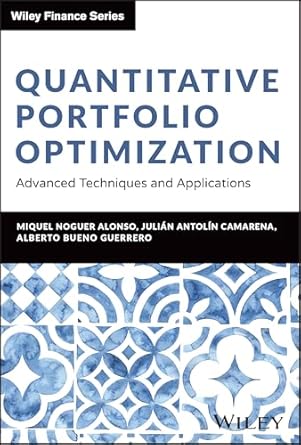Quantitative portfolio optimization
advanced techniques and applications
- ISBN: 9781394281312
- Editorial: John Wiley & Sons, Inc.
- Fecha de la edición: 2025
- Lugar de la edición: New York. Estados Unidos de Norteamérica
- Colección: Wiley Finance Series
- Encuadernación: Cartoné
- Medidas: 24 cm
- Nº Pág.: 384
- Idiomas: Inglés

Expert guidance on implementing quantitative portfolio optimization techniques
In Quantitative Portfolio Optimization: Theory and Practice, renowned financial practitioner Miquel Noguer, alongside physicists Alberto Bueno Guerrero and Julian Antolin Camarena, who possess excellent knowledge in finance, delve into advanced mathematical techniques for portfolio optimization. The book covers a range of topics including mean-variance optimization, the Black-Litterman Model, risk parity and hierarchical risk parity, factor investing, methods based on moments, and robust optimization as well as machine learning and reinforcement technique. These techniques enable readers to develop a systematic, objective, and repeatable approach to investment decision-making, particularly in complex financial markets.
Readers will gain insights into the associated mathematical models, statistical analyses, and computational algorithms for each method, allowing them to put these techniques into practice and identify the best possible mix of assets to maximize returns while minimizing risk. Topics explored in this book include:
Specific drivers of return across asset classes
Personal risk tolerance and it's impact on ideal asses allocation
The importance of weekly and monthly variance in the returns of specific securities
Serving as a blueprint for solving portfolio optimization problems, Quantitative Portfolio Optimization: Theory and Practice is an essential resource for finance practitioners and individual investors It helps them stay on the cutting edge of modern portfolio theory and achieve the best returns on investments for themselves, their clients, and their organizations.
CHAPTER 1: Introduction
1.1 Evolution of Portfolio Optimization
1.2 Role of Quantitative Techniques
1.3 Organization of the Book
CHAPTER 2: History of Portfolio Optimization
2.1 Early beginnings
2.2 Harry Markowitz's Modern Portfolio Theory (1952)
2.3 Black-Litterman Model (1990s)
2.4 Alternative Methods: Risk Parity, Hierarchical Risk Parity and Machine Learning
2.4.1 Risk Parity
2.4.2 Hierarchical Risk Parity
2.4.3 Machine Learning 2.5 Notes
PART ONE: Foundations of Portfolio Theory
CHAPTER 3: Modern Portfolio Theory
3.1 Efficient Frontier and Capital Market Line
3.1.1 Case Without Riskless Asset
3.1.2 Case With a Riskless Asset
3.2 Capital Asset Pricing Model
3.2.1 Case Without Riskless Asset
3.2.2 Case With a Riskless Asset
3.3 Multifactor Models
3.4 Challenges of Modern Portfolio Theory
3.4.1 Estimation Techniques in Portfolio Allocation
3.4.2 Non-Elliptical Distributions and Conditional Value-at-Risk (CVaR)
3.5 Quantum Annealing in Portfolio Management 3.6 Mean-Variance Optimization with CVaR Constraint
3.6.1 Problem Formulation
3.6.2 Optimization Problem
3.6.3 Clarification of Optimization Classes
3.6.4 Numerical Example
3.7 Notes
CHAPTER 4: Bayesian Methods in Portfolio Optimization
4.1 The Prior
4.2 The Likelihood
4.3 The Posterior
4.4 Filtering
4.5 Hierarchical Bayesian Models
4.6 Bayesian Optimization
4.6.1 Gaussian Processes in a Nutshell
4.6.2 Uncertainty Quantification and Bayesian Decision Theory
4.7 Applications to Portfolio Optimization
4.7.1 GP Regression for Asset Returns 4.7.2 Decision Theory in Portfolio Optimization
4.7.3 The Black-Litterman Model
4.8 Notes
PART TWO: Risk Management
CHAPTER 5: Risk Models and Measures
5.1 Risk Measures
5.2 VaR and CVaR
5.2.1 VaR
5.2.2 CVaR
5.3 Estimation Methods
5.3.1 Variance-Covariance Method
5.3.2 Historical Simulation
5.3.3 Monte Carlo Simulation
5.4 Advanced Risk Measures: Tail Risk and Spectral Measures
5.4.1 Tail Risk Measures
5.4.2 Spectral Measures
5.5 Notes
CHAPTER 6: Factor Models and Factor Investing
6.1 Single and Multifactor Models
6.1.1 Statistical Models 6.1.2 Macroeconomic Models
6.1.3 Cross-sectional Models
6.2 Factor Risk and Performance Attribution
6.3 Machine Learning in Factor Investing
6.4 Notes
CHAPTER 7: Market Impact, Transaction Costs, and Liquidity
7.1 Market Impact Models
7.2 Modeling Transaction Costs
7.2.1 Single Asset
7.2.2 Multiple Assets
7.3 Optimal Trading Strategies
7.3.1 Mei, DeMiguel, and Nogales (2016)
7.3.2 Skaf and Boyd (2009
7.4 Liquidity Considerations in Portfolio Optimization
7.4.1 MV and Liquidity
7.4.2 CAPM and Liquidity
7.4.3 APT and Liquidity
7.5 Notes






